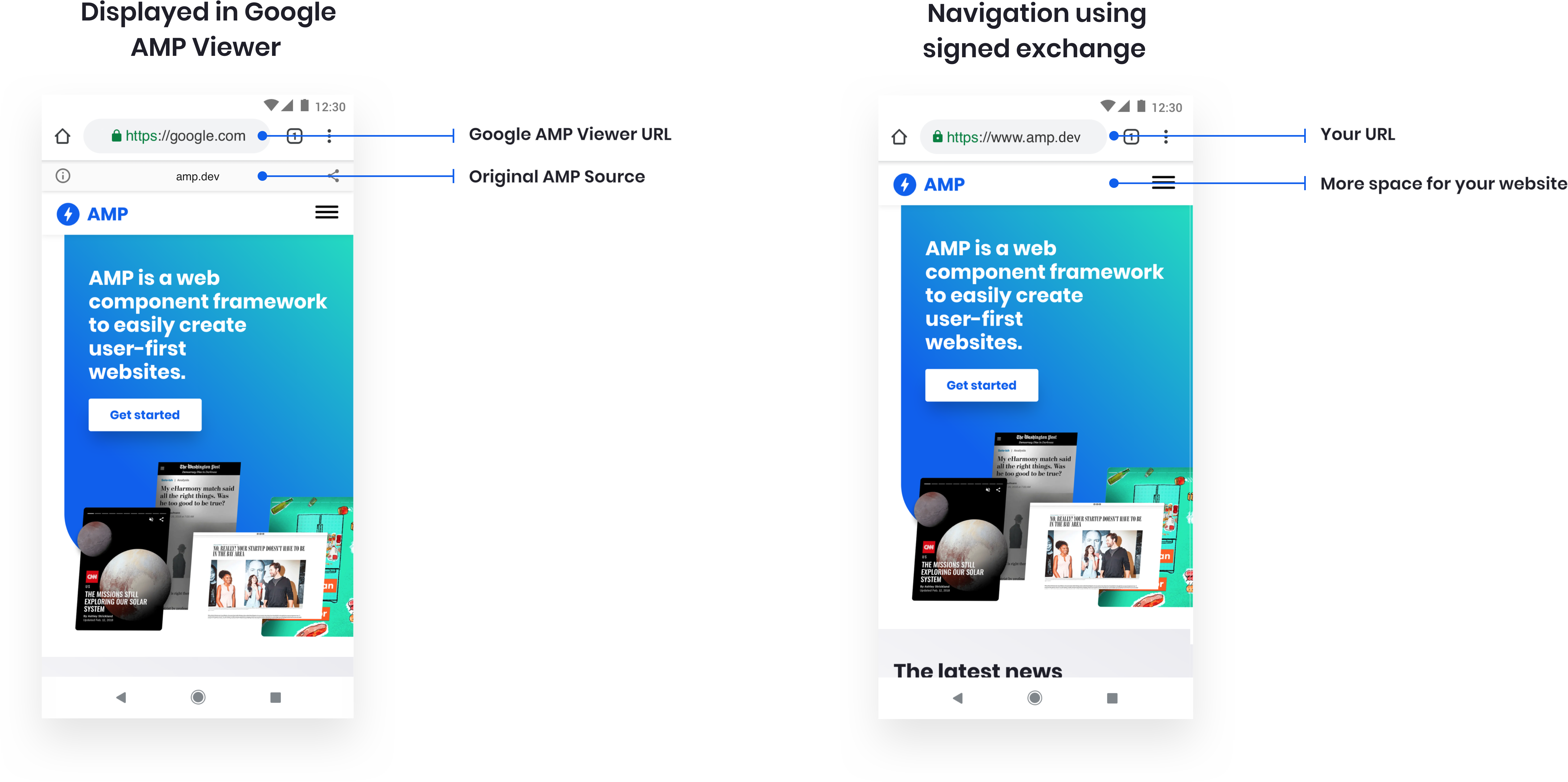AMP가 검색결과에서 작동하는 방식 이해하기
Google 검색은 빠르고 안정적인 웹 환경을 제공하기 위해 AMP 페이지의 색인을 생성합니다. AMP 페이지가 있는 경우 리치 결과와 캐러셀의 일부로 모바일 검색에 표시될 수 있습니다. AMP 자체는 순위 지정 요소가 아니지만 Google 검색에서 속도는 순위 지정 요소입니다. Google 검색은 페이지를 만드는 데 사용한 기술과 관계없이 모든 페이지에 같은 기준을 적용합니다. AMP를 사용했을 때의 이점을 자세히 알아보려면 AMP 프로젝트 성공사례를 참고하세요.
사용자가 AMP 페이지를 선택하면 Google 검색이 Google AMP Cache에서 페이지를 가져와 페이지를 즉시 표시하는 다양한 로드 최적화(예: 사전 렌더링)를 실행합니다. 현재 데스크톱의 AMP 페이지는 Google AMP 캐시/AMP 뷰어에서 제공되지 않습니다. 표준 AMP 페이지는 기본 검색결과처럼 작동합니다.
Google 검색결과에서 처음 표시되는 내용
AMP 페이지도 웹상의 다른 페이지와 비슷하게 Google 검색에 리치 결과로 표시될 수 있습니다. Google에서 페이지를 더 효과적으로 파악할 수 있도록 페이지에 구조화된 데이터를 추가할 수 있습니다. 다만 구조화된 데이터를 추가해도 검색결과에 리치 결과가 사용되지 않을 수 있습니다. 자세한 내용은 구조화된 데이터 일반 가이드라인을 참조하세요.
동일한 콘텐츠에 관한 중복 페이지가 있는 경우 표준 페이지뿐 아니라 모든 중복 페이지에 동일한 구조화된 데이터를 배치하세요. 게재위치에 관한 자세한 내용은 구조화된 데이터 일반 가이드라인을 참조하세요.
AMP 페이지는 웹 스토리로도 표시될 수 있습니다. Google 검색에서 웹 스토리를 사용 설정하는 방법을 자세히 알아보세요.
사용자가 AMP 콘텐츠를 클릭할 경우
사용자가 Google 검색에서 내 AMP 콘텐츠를 클릭하면 AMP 콘텐츠는 다음 두 가지 방식 중 하나로 표시될 수 있습니다.
- Google AMP 뷰어: 사용자가 콘텐츠 게시자를 알 수 있도록 콘텐츠의 도메인이 Google AMP 뷰어 상단에 표시됩니다.
- 서명된 교환: 브라우저에서 문서를 내 출처에 속한 것으로 처리하는 기술입니다.

Google AMP 뷰어 소개
Google AMP 뷰어는 Google AMP 뷰어를 지원하는 브라우저에서 사용자에 관한 데이터를 수집할 수 있는 하이브리드 환경입니다. Google AMP 뷰어는 Google 시스템에서 유용한 사용자 환경을 제공할 수 있다고 판단하는 경우, 특히 콘텐츠를 스와이프할 것으로 예상되는 경우 렌더링 될 수 있습니다. Google에서 데이터를 수집하는 경우 Google의 개인정보처리방침이 적용됩니다. Google AMP 뷰어에 콘텐츠가 표시되는 AMP 페이지 게시자가 데이터를 수집할 때는 게시자의 개인정보처리방침이 적용됩니다. 게시자는 AMP 페이지의 동작과 공급업체 통합을 선택하므로 이러한 선택으로 발생하는 규정 준수 의무를 이행할 책임이 있습니다.
서명된 교환 소개
서명된 교환을 사용하면 제1사 쿠키를 통해 콘텐츠를 맞춤설정하고 분석 내용을 측정할 수 있습니다. 페이지는 google.com/amp URL 대신 내 URL에 표시됩니다.
Google 검색은 서명된 교환을 지원하는 브라우저에서 Google AMP 뷰어를 사용하는 것보다 서명된 교환으로 콘텐츠에 연결하는 것을 우선시합니다. 사용자에게 이 형식으로 결과를 제공하려면 AMP 콘텐츠를 일반 AMP HTML 형식 외에도 서명된 교환으로 게시해야 합니다.
현재 서명된 교환은 Google 검색에서 리치 결과와 기본 결과에만 지원되며, 캐러셀에는 지원되지 않습니다. AMP 페이지에 서명된 교환을 설정하는 방법을 자세히 알아보려면 서명된 교환을 사용하여 AMP 게재하기를 참조하세요.
